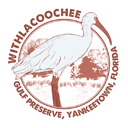
The Florida black bear, Ursus americanus floridanus, can be found throughout Florida, including Yankeetown! This subspecies of the American black bear was listed as threatened in the 1970’s, with a population in the low hundreds. Today biologists estimate the black bear population in Florida to be above 4,000. This is a tenfold increase from the historic low.
With this success comes an increase in people and bear encounters. In the Big Bend region sightings are not uncommon. If you see a bear from a distance, feel fortunate and enjoy the experience. If you encounter a bear at close range, avoid eye contact and back away slowly, while speaking to the bear in a calm assertive voice. Hold your ground if a bear huffs or snorts, paws the ground, or charges toward you. If you do the bear will likely stop and move away.
Florida bears generally have black fur with a tan muzzle. Adult bears range in weight from 150 to 400 pounds (68 to 181 kg), with males often twice the size of females.
The bear breeding season in Florida runs from June to August. Bear cubs weight about 12 oz. (350 g) at birth, with litter size between 1 and 5. The gestation period lasts 235 days, and litters are usually born in late January to early February.
Bears are omnivores and range over a large area to forage: 15 square miles for female and 62 square miles for males. Their diet is derived 80% from plants (fruits, berries, nuts), 15% from insects, and 5% from meat such as opossums, armadillos, and carrion.
The Friend’s would like to thank Vic Doig, Wildlife Biologist & Fire Management Officer at the US Fish & Wildlife Service, and Brian Scheick, Bear Research Program Coordinator at the Florida Fish and Wildlife Conservation Commission (FWC) for several great presentations at the WGP Education Center. For more information about Florida black bears visit FWC at: myfwc.com/research/wildlife/terrestrial-mammals/bear/.





 If you have walked the trails at the Preserve you may not have given lichens a second thought. Or perhaps mistaken them for another organism, like a moss. If this is the case, then you have missed out on wonders of the natural world.
If you have walked the trails at the Preserve you may not have given lichens a second thought. Or perhaps mistaken them for another organism, like a moss. If this is the case, then you have missed out on wonders of the natural world.

 The WGP management plan calls for the periodic survey of the Preserve for invasive plants. Yankeetown was fortunate to have Marc Frank (Extension Botanist, UF/IFAS), Lucas Majure (Curator at UF Herbarium), and several of their colleague and students conduct a survey on October 5, 2018.
The WGP management plan calls for the periodic survey of the Preserve for invasive plants. Yankeetown was fortunate to have Marc Frank (Extension Botanist, UF/IFAS), Lucas Majure (Curator at UF Herbarium), and several of their colleague and students conduct a survey on October 5, 2018. 
 A Super Blue Blood Moon as seen from the Preserve’s Observation Tower. This rare astronomical event triplet happened in the early morning of January 31, 2018.
A Super Blue Blood Moon as seen from the Preserve’s Observation Tower. This rare astronomical event triplet happened in the early morning of January 31, 2018.

